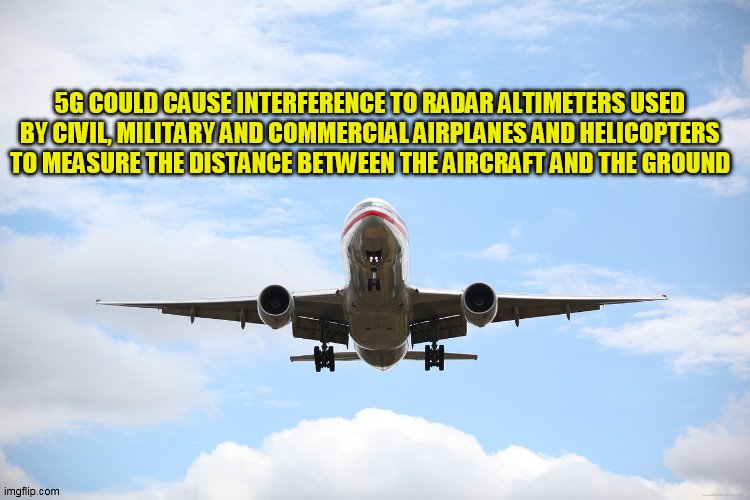 By B.N. Frank
By B.N. Frank
American opposition to 5G technology has been ongoing for years due to various significant safety risks associated with the controversial technology. Last month, AT&T and Verizon had agreed to delay additional deployment until January 5 due to warnings about aviation safety risks (see 1, 2). Airlines, the Federal Aviation Association (FAA), and transportation secretary, Pete Buttigieg asked for more time but the telecoms rejected their request. They have agreed to “alter” their plans for 6 months though.
From PC Mag:
FAA Asks Verizon and AT&T to Delay Mid-Band 5G Near ‘Priority’ Airports
The administration fears that C-band would interfere with altimeters. But AT&T and Verizon say they’ll only agree to ‘alter’ their plans for six months, not halt them entirely.
The Federal Aviation Administration (FAA) has asked Verizon and AT&T to delay the introduction of C-band service, which promises to offer 5G experiences that are noticeably better than 4G, around “priority airports” due to ongoing concerns about the potential impact on altimeters.
Altimeters measure an aircraft’s current altitude. Interfering with that information could make landing a plane during inclement weather more dangerous. The FAA is tasked with making flight as safe as possible, so it wants to determine if C-band deployments could endanger flyers.
As for why Verizon, AT&T, and other companies are interested in C-band: The goal is to introduce 5G networks that can outperform LTE across large distances. Many existing 5G networks, especially in the US, are forced to choose between performance and range.
The administration previously asked Verizon and AT&T to delay their C-band rollout from Dec. 5 to Jan. 5. The companies agreed, but on Dec. 31, Secretary of Transportation Pete Buttigieg and FAA Administrator Steve Dickson asked for more time to evaluate C-band’s safety implications.
“Under this framework,” the duo says, “commercial C-band service would begin as planned in January with certain exceptions around priority airports. The FAA and the aviation industry will identify priority airports where a buffer zone would permit aviation operations to continue safely while the FAA completes its assessments of the interference potential around those airports.”
Buttigieg and Dickson also say the FAA’s goal is for C-band “to deploy around these priority airports on a rolling basis, such that C-Band planned locations will be activated by the end of March 2022, barring unforeseen technical challenges or new safety concerns.”
But first, the FAA wants Verizon and AT&T to delay the C-band’s debut for “no more than two weeks beyond the currently scheduled deployment date of January 5” so it can determine what qualifies as a “priority airport” and how large the buffer zone needs to be.
An ‘Irresponsible Abdication’
In a joint letter to Buttigieg and Dickson, published by The Wall Street Journal, Verizon and AT&T pushed back on the request. “The question of whether 5G operations can safely coexist with aviation has long been established,” write Joan Marsh, AT&T’s EVP of Federal Regulatory Relations, and William H. Johnson, Verizon’s SVP of Federal Regulatory and Legal Affairs.
Agreeing to another delay would be “an unprecedented and unwarranted circumvention of the due process and checks and balances carefully crafted in the structure of our democracy, [and] an irresponsible abdication of the operating control required to deploy world-class and globally competitive communications networks that are every bit as essential to our country’s economic vitality, public safety and national interests as the airline industry,” say Marsh and Johnson.
The execs say AT&T and Verizon will instead “alter our use of the C-Band spectrum” for six months—until July 5, 2022—to create exclusion zones around runways at certain airports, an approach that’s already in place in France.
“France provides a real-world example of an operating environment where 5G and aviation safety already co-exist. The laws of physics are the same in the United States and France,” Marsh and Johnson say.
Other grave risks associated with 5G include
- Cybersecurity risks (see 1, 2, 3, 4)
- Environmental risks (see 1, 2, 3, 4, 5, 6)
- Health risks (see 1, 2, 3, 4, 5)
- Privacy risks (see 1, 2, 3)
- Weather forecasting satellite interference risks
- Utility infrastructure interference risks
Studies have also determined that 4G is still better, more reliable, and safer than 5G (see 1, 2, 3, 4, 5, 6, 7).
Opposition and warnings have slowed and/or stopped 5G deployment in some places but not others. Since 2017 doctors and scientists have asked for moratoriums on Earth and in space (see 1, 2) and the majority of scientists oppose deployment. Since 2018 there have been reports of people and animals experiencing symptoms and illnesses after 5G was activated (see 1, 2, 3, 4). Some blame the COVID Crisis on 5G deployment while others do not. Regardless, there are health risks associated with 5G exposure as well as exposure to 4G and other sources of wireless Wi-Fi radiation (see 1, 2) and Electromagnetic Fields (aka “Electrosmog”).
Activist Post reports regularly about 5G and other unsafe technology. For more information visit our archives and the following websites.
- Americans for Responsible Technology
- 5GFree
- 5G Information
- WhatIs5G.info
- 5G Space Appeal
- Stop 5G International
- Wireless Information Network
- Electromagnetic Radiation Safety
- Environmental Health Trust
- Physicians for Safe Technology
Become a Patron!
Or support us at SubscribeStar
Donate cryptocurrency HERE
Subscribe to Activist Post for truth, peace, and freedom news. Follow us on Telegram, HIVE, Flote, Minds, MeWe, Twitter, Gab and What Really Happened and GETTR.
Provide, Protect and Profit from what’s coming! Get a free issue of Counter Markets today.

Be the first to comment on "Telecoms Will Only “create exclusion zones around runways at certain airports” Due to 5G Aviation Warnings"